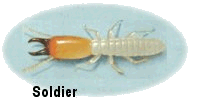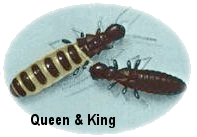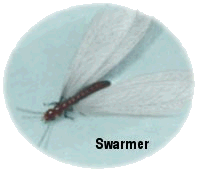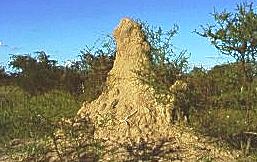Termites
All members of the order Isoptera are eusocial insects. Termites feed primarily on the cellulose and lignin found in plant cell walls; these compounds are the main ingredients of wood and all paper products. Termites cannot digest the cellulose directly so they rely upon symbiotic bacteria and protozoa living within their intestines to supply most of the enzymes needed for cellulose digestion. Termites are sometimes called white ants. They may resemble ants in size, but ants have a narrow waist and elbowed antennae while termites have a thick waist and antennae that resemble a string of beads.
Ecologically, termites play an important role in the environment by helping to break down and recycle dead wood and other plant tissues. They become pests when their appetite for wood and wood products extends to human homes, fence posts, building materials, cardboard, and other valuable products. In tropical and subtropical forests where termites are abundant, railroads must use expensive metal ties because wooden ones are quickly destroyed.
The Termite Colony.
Each termite lives in a nest or colony with hundreds, thousands, or even millions of its brothers and sisters. In fact, the termite colony is really a large, extended family. Within this family, various groups of individuals have different functional roles according to a “caste system”.

 The worker caste is the largest group. It consists entirely of immatures, both males and females. These soft-bodied, wingless individuals perform all of the hard labor in the colony: they clean, maintain, and repair the nest, gather food and water, care for the young, and construct new tunnels and galleries as the colony grows. These juveniles all have the genetic capacity to undergo additional molts and become soldiers or reproductives, but most will spend their entire lives as workers.
The worker caste is the largest group. It consists entirely of immatures, both males and females. These soft-bodied, wingless individuals perform all of the hard labor in the colony: they clean, maintain, and repair the nest, gather food and water, care for the young, and construct new tunnels and galleries as the colony grows. These juveniles all have the genetic capacity to undergo additional molts and become soldiers or reproductives, but most will spend their entire lives as workers. Members of the soldier caste are larger in size but fewer in number than the workers. They are also wingless, but they have large heads with powerful jaws. Their job is to guard the nest site and protect it from attacks by ants or other invaders. In some species the soldiers lack jaws but have a large gland in the head that shoots defensive chemicals through a nozzle at the front of the head. The soldiers are unable to care for themselves so they must be fed and groomed by the workers.
Members of the soldier caste are larger in size but fewer in number than the workers. They are also wingless, but they have large heads with powerful jaws. Their job is to guard the nest site and protect it from attacks by ants or other invaders. In some species the soldiers lack jaws but have a large gland in the head that shoots defensive chemicals through a nozzle at the front of the head. The soldiers are unable to care for themselves so they must be fed and groomed by the workers. The reproductive caste always includes a king (male) and a queen (female) who are the parents of the termite family and founders of the colony. Some species also have a few supplemental reproductives who share the egg laying duties. These are the only adult insects in the colony. The queen lays large numbers of eggs which develop into more workers and soldiers as the family grows.
The reproductive caste always includes a king (male) and a queen (female) who are the parents of the termite family and founders of the colony. Some species also have a few supplemental reproductives who share the egg laying duties. These are the only adult insects in the colony. The queen lays large numbers of eggs which develop into more workers and soldiers as the family grows. In every mature colony, there also develops an annual population of young winged reproductives that swarm from the parent nest for a short mating flight. After flight, the delicate wings break off, and the new king and queen set out to find another nest site and start a new colony. Large colonies with multiple reproductives may also split into two or more daughter colonies, a process known as “budding”.
In every mature colony, there also develops an annual population of young winged reproductives that swarm from the parent nest for a short mating flight. After flight, the delicate wings break off, and the new king and queen set out to find another nest site and start a new colony. Large colonies with multiple reproductives may also split into two or more daughter colonies, a process known as “budding”. The termite’s caste system is regulated by pheromones. The king and queen each produce special pheromones that circulate throughout the colony and inhibit workers of the same sex from molting into reproductive adults. A death in the royal family (or an increase in the size of the colony) results in a lower concentration of the corresponding pheromone and, subsequently, one or more workers will molt into replacement reproductives. Likewise, the concentration of sex-specific soldier pheromones regulate the numbers of male and female soldiers to fall within an optimal range based on colony size. Excess numbers of soldiers or reproductives may be killed and eaten by the workers.
The termite’s caste system is regulated by pheromones. The king and queen each produce special pheromones that circulate throughout the colony and inhibit workers of the same sex from molting into reproductive adults. A death in the royal family (or an increase in the size of the colony) results in a lower concentration of the corresponding pheromone and, subsequently, one or more workers will molt into replacement reproductives. Likewise, the concentration of sex-specific soldier pheromones regulate the numbers of male and female soldiers to fall within an optimal range based on colony size. Excess numbers of soldiers or reproductives may be killed and eaten by the workers. In Africa and Australia, other subterranean species mix bits of soil with saliva to build nest mounds that are up to 20 feet (6 meters) tall. The inside of the mound is divided into numerous chambers and galleries. The king and queen live in a special cell deep inside the mound. The female’s abdomen grows in size until it is large enough to hold many thousands of eggs. The queen lays these eggs at the rate of several thousand a day. Worker termites carry the eggs away to specially constructed cells in the nest. There the workers care for the young as they hatch from the eggs.
In Africa and Australia, other subterranean species mix bits of soil with saliva to build nest mounds that are up to 20 feet (6 meters) tall. The inside of the mound is divided into numerous chambers and galleries. The king and queen live in a special cell deep inside the mound. The female’s abdomen grows in size until it is large enough to hold many thousands of eggs. The queen lays these eggs at the rate of several thousand a day. Worker termites carry the eggs away to specially constructed cells in the nest. There the workers care for the young as they hatch from the eggs.